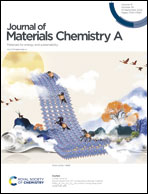Tunable CuO nanostructured thin films derived from metal–organic frameworks for dehydrogenation of alcohols†
Abstract
Metal–Organic Frameworks (MOFs) are an important class of materials that are gaining increasing relevance for many fields including thin films, CO2 capture, photovoltaics, and catalysts. MOF mediated synthesis (MOFMS) is the decomposition of a MOF to form an amorphous carbon material decorated with metal nanoparticles. MOF thin films are an area where MOFMS has not been thoroughly explored, yet they are likely to be industrially relevant. In this work, we have developed a method for the growth of a copper-based MOF thin film on silicon-based supports. A series of decomposition processes have allowed us to determine which variables can be used to design the final nanoparticle decorated product. These variables include oxygen/nitrogen ratios, the impact of water in atmospheric decomposition, substrate composition, and reduction under hydrogen. A high degree of control over the final thin film product is achieved, with the ability to make a carbon-supported CuO structure with features between 1 and 5 nm, or CuO nanoparticles ranging from 10–500 nm, as well as finely tuned carbon/Cu ratios. Finally, partially reduced samples were obtained and used in the dehydrogenation of ethanol and methanol. Understanding these decomposition variables as applied to supported MOF-thin films will enable development of next generation nanomaterials for use in catalysis.



 Please wait while we load your content...
Please wait while we load your content...